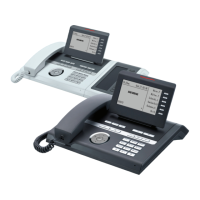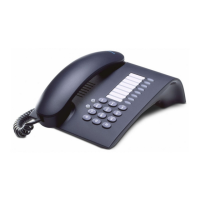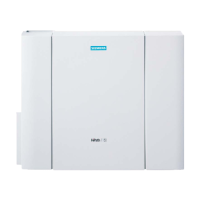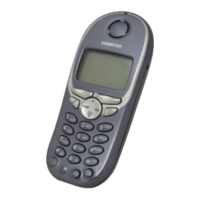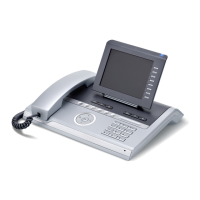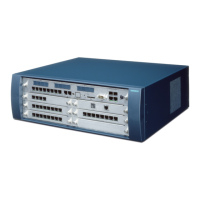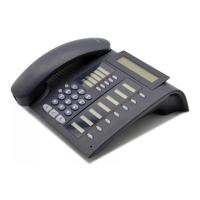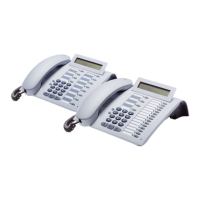Do you have a question about the Siemens HiPath OpenOffice and is the answer not in the manual?
Information about trademarks and compliance markings for the device.
Guidelines for optimal placement and environmental conditions for the telephone.
Information on software updates and online product support resources.
Introduces the phone's main interface elements like display, keys, and keypad.
Identifies and explains the physical ports on the underside of the phone.
Describes using the phone's built-in switch for PC connectivity to save network ports.
Information about the OpenStage Manager program for phone customization and configuration.
Details the function and attachment of the optional OpenStage Key Module for expanded keys.
Explains the function of keys like function, audio, and the TouchSlider for phone operation.
Describes how mode keys are used to switch between different phone applications and features.
Explains how to use the TouchGuide control for navigating phone menus and options.
Information on programming and using sensor keys for functions, numbers, or procedures.
Guide to entering text, numbers, and special characters using the keypad and display.
Details on using the phone's keypad for text input and accessing multi-function keys.
Explains the phone's color display, appearance settings, and status bar icons.
How to use the on-screen display keyboard for text input and selecting functions.
How to switch between and access various applications on the phone.
Describes the phone's interface for calls and shows icons for frequent call states.
Overview of personal, corporate, and LDAP phonebooks, including search functions.
Information on viewing, managing, and deleting call history entries.
Instructions for sending, viewing, and managing text messages and voicemails.
How to access and navigate the phone's settings and service menus.
How to receive incoming calls via handset, speakerphone, or headset.
Covers various methods for initiating phone calls, including off-hook and on-hook dialing.
Procedures for terminating an active phone call using the handset or specific keys.
How to mute the microphone during a call for privacy.
How to call a second party, switch between calls, and initiate conferences.
How to redirect an active call to another extension or person.
Requesting, storing, and accepting callbacks for busy or unanswered lines.
Covers answering calls via headset, for other phones, and using speakerphone.
Speaking with visitors at an entrance and operating door openers.
Methods for initiating calls, including redialing, phonebooks, LDAP, and speed dial.
Managing incoming second calls, call waiting, and camp-on tones.
Holding calls on specific lines and retrieving them later.
Setting up, managing, and ending multi-party conference calls.
Functionality to record an active phone conversation.
Activating ISDN services using trunk flash signals.
Handling situations where a call destination cannot be reached, including busy override.
Forwarding calls to a designated station during non-business hours.
How active call forwarding status is displayed on the phone.
Lists and explains the different types of call forwarding available.
Using a dedicated key to activate/deactivate and edit call forwarding instructions.
How to specify numbers or contacts as forwarding destinations.
Saving frequently used forwarding destinations for quick access.
Quickly activating call forwarding for all incoming calls.
Activating and deactivating call forwarding using the Program/Service menu.
How to turn off active call forwarding.
Forwarding calls when there is no answer after a set number of rings.
Forwarding calls automatically if the phone experiences failure.
Forwarding calls via carrier network and multiple subscriber numbers.
Programming function keys for quick access to phone features and operations.
Saving sequences of steps or procedures onto programmable keys.
Programming keys for redialing numbers or accessing second-level functions.
Modifying the displayed text labels for programmed keys.
Removing programmed functions and settings from sensor keys.
Creating, editing, and managing personal contact entries and groups.
Searching and importing contacts from an LDAP corporate directory.
Viewing, deleting, and copying call history entries.
Displaying and assigning call charge details for calls.
Explains voice encryption for secure calls and related warnings.
Setting and managing a user password for phone access and security.
Activating and deactivating the phone's ringer for silent operation.
Activating DND to block incoming calls and prevent ringing.
Hiding your phone number when making calls to external parties.
Securing the phone with a lock code to prevent unauthorized use.
Locking or unlocking other telephones remotely to prevent unauthorized access.
Setting and managing a Personal Identification Number (PIN) for security functions.
Setting timed reminders for appointments and managing saved reminders.
Sending short text messages and managing sent/received messages.
Leaving messages on the display for internal callers during absence.
Using your phone's connection from another telephone or device.
Setting up and managing mobile connections, including data privacy and mobility variants.
Logging onto and off of guest telephone connections, managing data.
Accessing system functions remotely using Direct Inward System Access (DISA).
Explanation of primary, secondary, private, shared, and direct call lines.
How programmable keys function as trunk keys and their LED indicators.
Answering, dialing, and placing calls on hold using trunk keys.
Using DSS keys to answer calls for team members and make direct calls.
How to transfer an active call to another person.
Setting up call forwarding for specific trunk lines.
Directly transferring calls to an executive's phone via Ring Transfer.
Activating/deactivating group call signals and managing group membership.
Answering calls designated for other team members.
Setting up and managing ringing groups for audible call signaling.
Logging on/off and managing agent status for UCD call distribution.
Requesting work time and managing UCD night service.
Leaving hunt groups or group calls when operating on a LAN.
Activating call forwarding from other phones on the network.
Configuring night answer service for other phones on the LAN.
Setting up and managing ringing groups for phones on the LAN.
Managing external relays on HiPath 3000 systems over the LAN.
Activating door openers connected via LAN.
Customizing display angle, screensaver, and brightness.
Choosing preferred color themes for the phone's menu display.
Adjusting the responsiveness level of the TouchGuide control.
Adjusting the contrast for key labels on the OpenStage Key Module.
Setting and adjusting various volume levels for ringer, handset, and speakerphone.
Configuring acoustic settings like Normal, Echoing, or Muffled.
Specifying whether a wired or cordless headset is connected to the phone.
Choosing preferred ringtones from available audio files or uploading custom ones.
Turning the phone's ringer on or off to manage incoming call alerts.
Enabling or disabling en-bloc dialing for call initiation.
Setting up and preparing the phone for Bluetooth connections.
Managing the phone's discoverability and the process of linking Bluetooth devices.
Setting and managing a PIN for Bluetooth pairing and security.
Managing linked devices, blacklisting, renaming, and deleting entries.
Configuring tones and indicators for unsecured voice connections.
Defining whether context menus should close automatically and their display duration.
Viewing IP addresses and web interface details for network access.
Restoring phone settings and user data to factory defaults.
Running a diagnostic test to check phone hardware and functions.
Making the phone discoverable and the process of linking Bluetooth devices.
Receiving contact information in vCard format from Bluetooth devices.
Transmitting contact data as vCards to other Bluetooth-enabled devices.
Connecting, preparing, and testing a Bluetooth headset with the OpenStage phone.
Instructions for physically connecting a USB memory stick to the phone.
Backing up phone settings, contacts, and other user data to a USB memory stick.
Recovering all previously saved user settings and data from a backup.
Restoring specific categories of user data from a backup file.
Verifying the contents and status of stored backups on the USB stick.
Removing unwanted backup files from the USB memory stick.
Accessing phone settings and user-specific configurations via the web interface.
Configuring phone and network settings via administrator login and password.
Detailed steps for modifying settings through the web interface, including button functions.
How to access the phone's web interface from a PC.
Explains common error messages, their causes, and possible solutions.
Provides general advice and steps for resolving common phone operational issues.
Instructions for cleaning and caring for the physical condition of the telephone.
Icons used to navigate different applications within the phone interface.
Icons indicating phone status, settings, and notifications in the status bar.
Icons representing message status, call list entries, and active call states.
Information about trademarks and compliance markings for the device.
Guidelines for optimal placement and environmental conditions for the telephone.
Information on software updates and online product support resources.
Introduces the phone's main interface elements like display, keys, and keypad.
Identifies and explains the physical ports on the underside of the phone.
Describes using the phone's built-in switch for PC connectivity to save network ports.
Information about the OpenStage Manager program for phone customization and configuration.
Details the function and attachment of the optional OpenStage Key Module for expanded keys.
Explains the function of keys like function, audio, and the TouchSlider for phone operation.
Describes how mode keys are used to switch between different phone applications and features.
Explains how to use the TouchGuide control for navigating phone menus and options.
Information on programming and using sensor keys for functions, numbers, or procedures.
Guide to entering text, numbers, and special characters using the keypad and display.
Details on using the phone's keypad for text input and accessing multi-function keys.
Explains the phone's color display, appearance settings, and status bar icons.
How to use the on-screen display keyboard for text input and selecting functions.
How to switch between and access various applications on the phone.
Describes the phone's interface for calls and shows icons for frequent call states.
Overview of personal, corporate, and LDAP phonebooks, including search functions.
Information on viewing, managing, and deleting call history entries.
Instructions for sending, viewing, and managing text messages and voicemails.
How to access and navigate the phone's settings and service menus.
How to receive incoming calls via handset, speakerphone, or headset.
Covers various methods for initiating phone calls, including off-hook and on-hook dialing.
Procedures for terminating an active phone call using the handset or specific keys.
How to mute the microphone during a call for privacy.
How to call a second party, switch between calls, and initiate conferences.
How to redirect an active call to another extension or person.
Requesting, storing, and accepting callbacks for busy or unanswered lines.
Covers answering calls via headset, for other phones, and using speakerphone.
Speaking with visitors at an entrance and operating door openers.
Methods for initiating calls, including redialing, phonebooks, LDAP, and speed dial.
Managing incoming second calls, call waiting, and camp-on tones.
Holding calls on specific lines and retrieving them later.
Setting up, managing, and ending multi-party conference calls.
Functionality to record an active phone conversation.
Activating ISDN services using trunk flash signals.
Handling situations where a call destination cannot be reached, including busy override.
Forwarding calls to a designated station during non-business hours.
How active call forwarding status is displayed on the phone.
Lists and explains the different types of call forwarding available.
Using a dedicated key to activate/deactivate and edit call forwarding instructions.
How to specify numbers or contacts as forwarding destinations.
Saving frequently used forwarding destinations for quick access.
Quickly activating call forwarding for all incoming calls.
Activating and deactivating call forwarding using the Program/Service menu.
How to turn off active call forwarding.
Forwarding calls when there is no answer after a set number of rings.
Forwarding calls automatically if the phone experiences failure.
Forwarding calls via carrier network and multiple subscriber numbers.
Programming function keys for quick access to phone features and operations.
Saving sequences of steps or procedures onto programmable keys.
Programming keys for redialing numbers or accessing second-level functions.
Modifying the displayed text labels for programmed keys.
Removing programmed functions and settings from sensor keys.
Creating, editing, and managing personal contact entries and groups.
Searching and importing contacts from an LDAP corporate directory.
Viewing, deleting, and copying call history entries.
Displaying and assigning call charge details for calls.
Explains voice encryption for secure calls and related warnings.
Setting and managing a user password for phone access and security.
Activating and deactivating the phone's ringer for silent operation.
Activating DND to block incoming calls and prevent ringing.
Hiding your phone number when making calls to external parties.
Securing the phone with a lock code to prevent unauthorized use.
Locking or unlocking other telephones remotely to prevent unauthorized access.
Setting and managing a Personal Identification Number (PIN) for security functions.
Setting timed reminders for appointments and managing saved reminders.
Sending short text messages and managing sent/received messages.
Leaving messages on the display for internal callers during absence.
Using your phone's connection from another telephone or device.
Setting up and managing mobile connections, including data privacy and mobility variants.
Logging onto and off of guest telephone connections, managing data.
Accessing system functions remotely using Direct Inward System Access (DISA).
Explanation of primary, secondary, private, shared, and direct call lines.
How programmable keys function as trunk keys and their LED indicators.
Answering, dialing, and placing calls on hold using trunk keys.
Using DSS keys to answer calls for team members and make direct calls.
How to transfer an active call to another person.
Setting up call forwarding for specific trunk lines.
Directly transferring calls to an executive's phone via Ring Transfer.
Activating/deactivating group call signals and managing group membership.
Answering calls designated for other team members.
Setting up and managing ringing groups for audible call signaling.
Logging on/off and managing agent status for UCD call distribution.
Requesting work time and managing UCD night service.
Leaving hunt groups or group calls when operating on a LAN.
Activating call forwarding from other phones on the network.
Configuring night answer service for other phones on the LAN.
Setting up and managing ringing groups for phones on the LAN.
Managing external relays on HiPath 3000 systems over the LAN.
Activating door openers connected via LAN.
Customizing display angle, screensaver, and brightness.
Choosing preferred color themes for the phone's menu display.
Adjusting the responsiveness level of the TouchGuide control.
Adjusting the contrast for key labels on the OpenStage Key Module.
Setting and adjusting various volume levels for ringer, handset, and speakerphone.
Configuring acoustic settings like Normal, Echoing, or Muffled.
Specifying whether a wired or cordless headset is connected to the phone.
Choosing preferred ringtones from available audio files or uploading custom ones.
Turning the phone's ringer on or off to manage incoming call alerts.
Enabling or disabling en-bloc dialing for call initiation.
Setting up and preparing the phone for Bluetooth connections.
Managing the phone's discoverability and the process of linking Bluetooth devices.
Setting and managing a PIN for Bluetooth pairing and security.
Managing linked devices, blacklisting, renaming, and deleting entries.
Configuring tones and indicators for unsecured voice connections.
Defining whether context menus should close automatically and their display duration.
Viewing IP addresses and web interface details for network access.
Restoring phone settings and user data to factory defaults.
Running a diagnostic test to check phone hardware and functions.
Making the phone discoverable and the process of linking Bluetooth devices.
Receiving contact information in vCard format from Bluetooth devices.
Transmitting contact data as vCards to other Bluetooth-enabled devices.
Connecting, preparing, and testing a Bluetooth headset with the OpenStage phone.
Instructions for physically connecting a USB memory stick to the phone.
Backing up phone settings, contacts, and other user data to a USB memory stick.
Recovering all previously saved user settings and data from a backup.
Restoring specific categories of user data from a backup file.
Verifying the contents and status of stored backups on the USB stick.
Removing unwanted backup files from the USB memory stick.
Accessing phone settings and user-specific configurations via the web interface.
Configuring phone and network settings via administrator login and password.
Detailed steps for modifying settings through the web interface, including button functions.
How to access the phone's web interface from a PC.
Explains common error messages, their causes, and possible solutions.
Provides general advice and steps for resolving common phone operational issues.
Instructions for cleaning and caring for the physical condition of the telephone.
Icons used to navigate different applications within the phone interface.
Icons indicating phone status, settings, and notifications in the status bar.
Icons representing message status, call list entries, and active call states.
